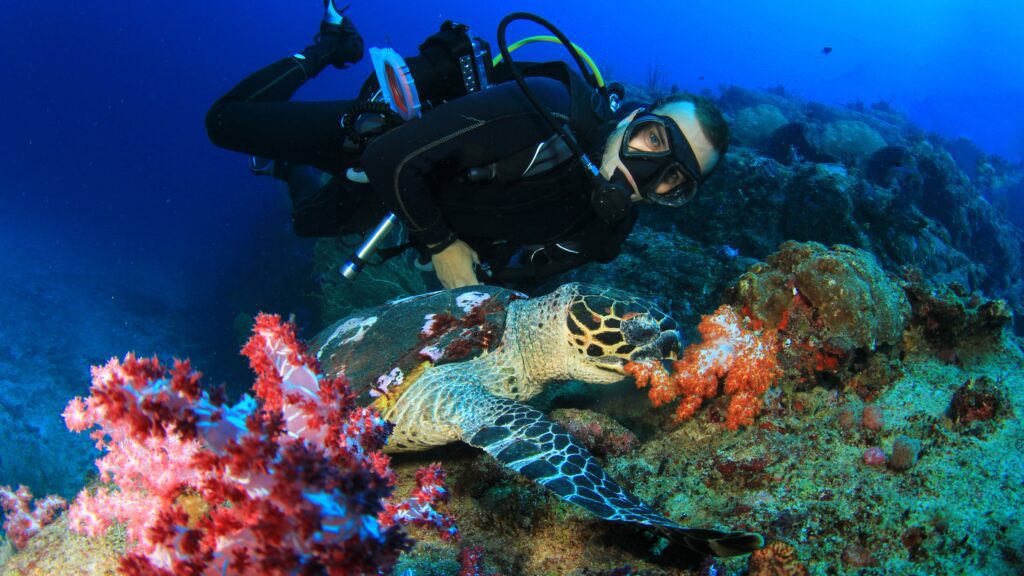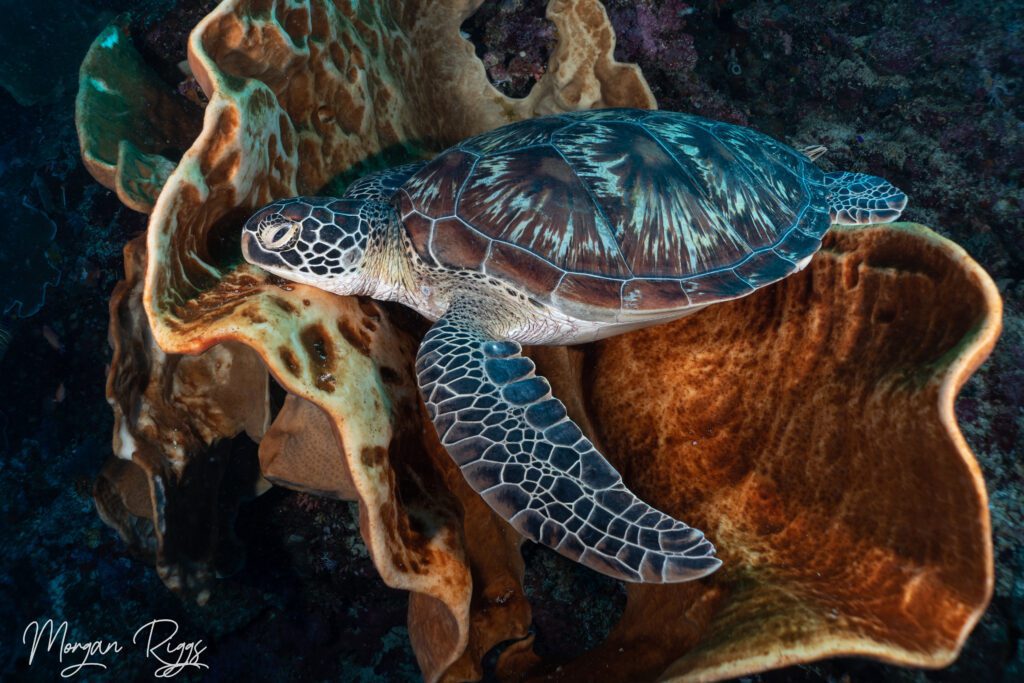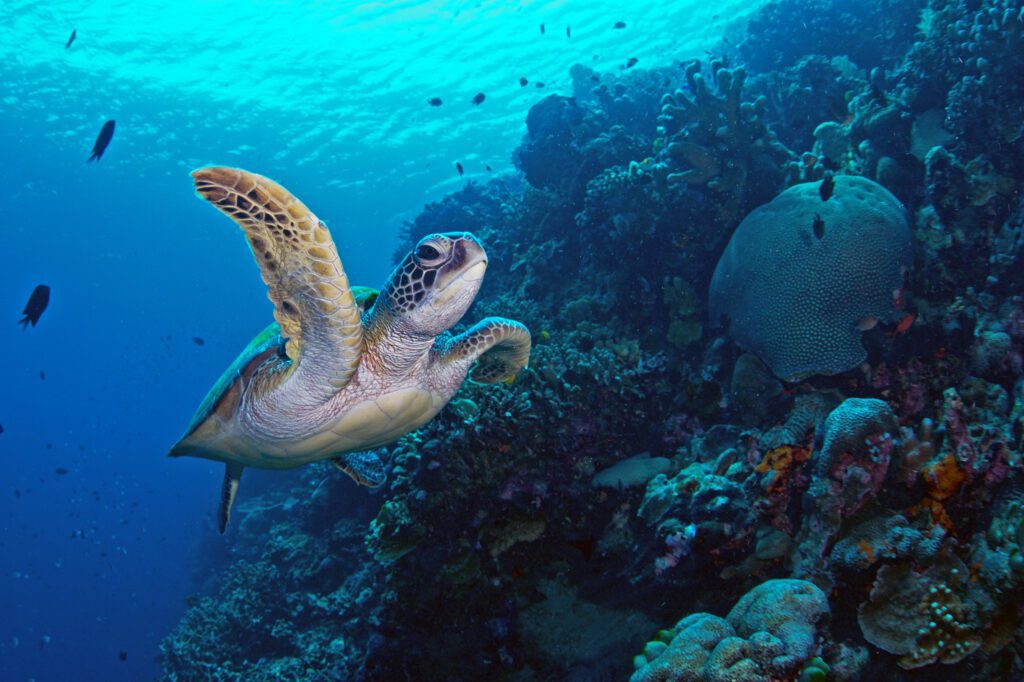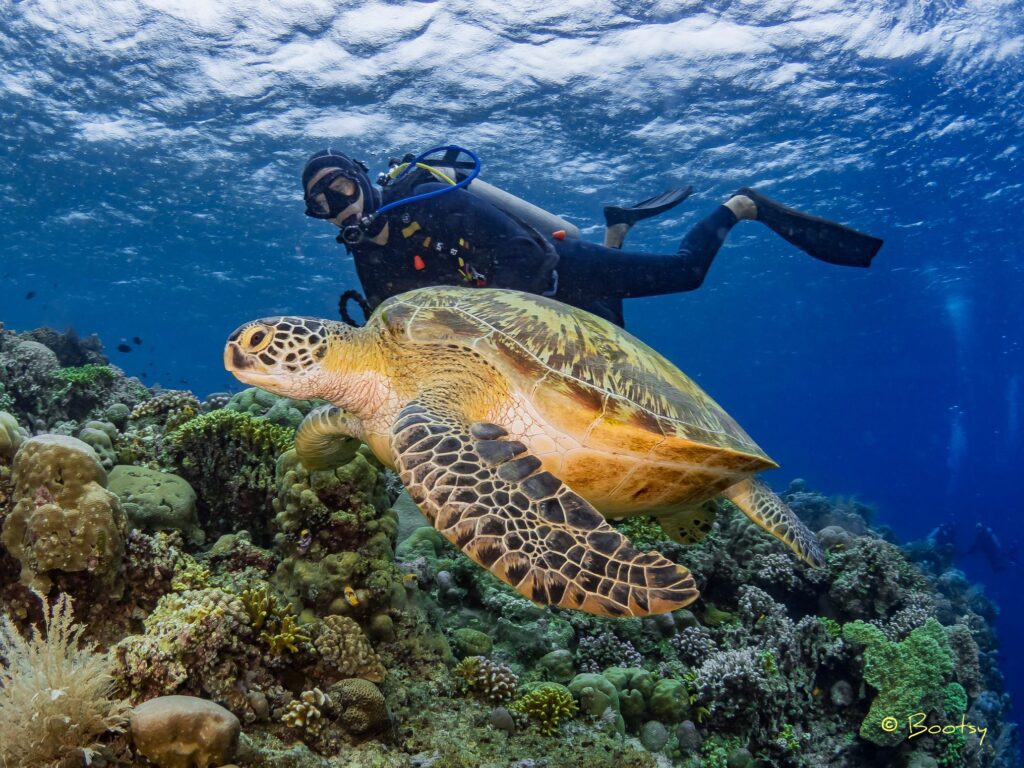Fascinating Sea Turtle Facts: Hawksbill & Green Sea Turtles
|March 20, 2024
There is no doubt that there is something mysterious, enchanting, and humbling about diving with sea turtles. These ancient creatures, which have life spans to match our own, are one of the longest-living of all sea creatures. There are 7 known species of sea turtle in the world and 5 of these species can be found in the Coral Triangle.
Here in North Sulawesi, located at the heart of the Coral Triangle, by far the most common species from these 7 are the green sea turtle and the hawksbill turtle, but how do you tell them apart? Read on to find out more…
Sea Turtle Facts: Hawksbill and Green Sea Turtles
Now, let’s dive deeper into the world of sea turtles! In this next section, we aim to show both the intriguing similarities AND captivating differences between the Hawksbill (Eretmochelys imbricata) and the Green Sea Turtle (Chelonia mydas).
1. Distinguishing Physical Characteristics

Green turtle (left) vs hawksbill turtle (right). Note the difference in the shell and the hawksbill’s “beak”
The most distinctive feature of a green turtle is its beautiful shell (carapace) while the most distinctive feature of a hawksbill turtle is its hawk-like beak – from where they take their name. These are just a few of the many sea turtle facts you’ll discover as we delve deeper into their physical distinctions.
A green sea turtle has a clean shell whereas a hawksbill turtle’s shell often gathers algae growth and appears mottled. The green sea turtle’s shell has a radiating pattern on the scutes (scales), while hawksbill turtles have interlocking scutes.
The beautiful golden hue of the green sea turtle’s shell contributed to its scientific name, ‘mydas’ meaning ‘gold’ in Latin. However, while the green sea turtle has a shell to be proud of, the same shell and the fat beneath it, are two reasons why this species has been heavily hunted in the past. Tortoiseshell ornaments, hair accessories (hair brush handles and hairpins), and other items were traditionally made from the shells of green sea turtles which were then highly polished to give a more lustrous finish. The fat beneath the green sea turtle’s shell was a key ingredient when making green turtle soup – and still is today in countries that still allow for this practice.
Green sea turtles have a round, lidded, yet open eye whereas hawksbill turtles have a more oval bird-like eye – another factor that relates to their ‘hawksbill’ common name.
2. Size and Weight

Huge green sea turtle next to Murex dive guide Basrah
Hawksbill turtles are one of the smallest species of sea turtles. An adult hawksbill can weigh from 45kg to 90kg (depending on whether it is male or female) whereas an adult green sea turtle can weigh up to 160kg – up to three times the weight.
Due to the green sea turtle’s larger size and heavier weight, they are much slower swimmers than hawksbill turtles. Hawksbills are one of the fastest swimmers out of all seven turtle species found around the world.
3. Behavior and Diet

Hawksbill turtle and scuba diver
Green and hawksbill turtles spend most of their lives as solitary creatures, only coming together to mate. Despite their independent nature, both species are surprisingly well-traveled. They’re highly migratory, documented swimming vast distances across open waters.
Interestingly, their dietary preferences differ. Hawksbill turtles are specialized sponge-eaters, while green sea turtles favor seagrasses and algae. However, both can adapt and survive on similar food sources if needed.
4. Reproduction

Sea turtle laying eggs
The females of both of these species will return to the very beaches on which they hatched, to nest and lay eggs of their own. However, the clutch size differs significantly between the two species. Hawksbill females can lay an impressive 200 eggs per nest, while green sea turtles typically lay between 75 and 150.
5. Threats

Sea green turtle in sponge
By far the most vulnerable of turtles are turtle hatchlings (and the eggs), of all species of turtles. While the eggs are buried in the sand (on the beach) they face threats from land predators including lizards, crabs, snakes, and other species that will dig for the eggs as a source of food. If the eggs survive the hatching stage, the hatchlings are easy prey for several larger marine predators while they are still in their juvenile stages.
However, once green sea turtles and hawksbill turtles reach maturity they have very few natural known predators. Due to their hard shells, their only real predators are certain species of sharks. This is one of the reasons why turtles are thought to be so long-lived.
Unfortunately, all sea turtle species face a multitude of manmade threats. These include entanglement in non-discriminatory longline fishing gear, habitat degradation, and declination of available food sources.
Sea Turtles in North Sulawesi

Green sea turtle
The Bunaken Marine Park is world-famous for its thriving resident population of green sea turtles. The number of turtles in the park appears to grow year on year and there are countless individuals measuring over 1 meter in length. Although this species is migratory – they seem very at home here in Bunaken!
Around Bangka Island and in the Lembeh Strait there are fewer turtle sightings than in the Bunaken Marine Park – but they are by no means unheard of. The majority of these sightings are of hawksbill turtles.
Learn Sea Turtle Facts by Swimming with Them

A green sea turtle with a scuba diver in North Sulawesi
Would you like to dive with sea turtles in North Sulawesi? To make the most of your time with us, and to optimize your chances of seeing both of these turtle species, join us for a Passport to Paradise and stay and dive with us in three distinct destinations: Bunaken, Bangka, and Lembeh. Instead of limiting yourself to one diving location, explore all three.
Enjoy spectacular wall diving in the Bunaken Marine Park from Murex Manado Resort, experience kaleidoscopic reefs around Bangka Island from Murex Bangka Resort, and dive into the world’s best muck and critter diving in the Lembeh Strait with Lembeh Resort.
Our resorts are connected by boat diving transfers which means no wasted travel time and even more time underwater as you simply dive your way from resort to resort!
GET IN TOUCH!
Contact us at reservations@murexresorts.com. You may also want to check out Murex Resorts’ rates and reserve your spot now.
We look forward to welcoming you to North Sulawesi!
FURTHER READING
After diving into these fascinating sea turtle facts, explore even more about North Sulawesi’s incredible marine life with our other articles on diving and ocean wonders!
- Bunaken Island: an underwater paradise with diverse marine life
- Explore the Best Areas for Diving in Sulawesi
- Unveiling the wonders of marine mammals: a comprehensive guide
The post Fascinating Sea Turtle Facts: Hawksbill & Green Sea Turtles appeared first on Murex Resorts.